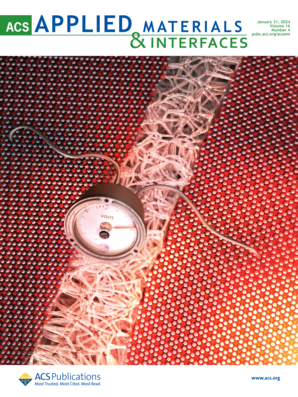Dendrimer-Entrapped CuPt Bimetallic Nanozymes for Tumor Microenvironment-Regulated Photothermal/Catalytic Therapy.
IF 8.3
2区 材料科学
Q1 MATERIALS SCIENCE, MULTIDISCIPLINARY
引用次数: 0
Abstract
Noble metal nanozymes have attracted extensive attention in tumor therapy due to their multiple enzyme-like activities for catalytic therapy and unique optical properties for photothermal therapy (PTT). However, their therapeutic efficiency may be compromised by the intricate tumor microenvironment (TME). Herein, copper-platinum (CuPt) bimetallic nanozymes were synthesized and entrapped by poly(amidoamine) dendrimers, with p-carboxybenzenesulfonamide (BS, a carbonic anhydrase IX (CA IX) inhibitor) modified on the surface and lonidamine (Lon) loaded inside to regulate TME for enhanced catalytic therapy and PTT. The formed CPL@G5-BS nanozymes could specifically target CA IX-overexpressed tumor cells and activate the cascade catalytic reaction with continuous •OH generation by the peroxidase-like property, O2 supply by the catalase-like property, and H2O2 replenishing by the superoxide dismutase-like property, thereby alleviating hypoxia and achieving chemodynamic therapy (CDT). In the TME, BS-mediated CA IX inhibition would normalize the extracellular pH to suppress metastasis while reducing the intracellular pH to boost the catalytic efficiency, and Lon-mediated mitochondrial respiration inhibition and energy metabolic disruption would elevate intracellular oxygen accumulation and downregulate heat shock protein (HSP) expression, further enhancing the PTT efficacy. Meanwhile, the excellent photothermal performance of CPL@G5-BS could amplify the multienzyme activities, and Cu2+-mediated glutathione depletion further improved the CDT efficiency. Overall, the CPL@G5-BS nanozymes can efficiently inhibit tumor growth and suppress metastasis by TME-regulated catalytic therapy and PTT.树突状包裹CuPt双金属纳米酶用于肿瘤微环境调节光热/催化治疗。
贵金属纳米酶由于具有多种酶样催化活性和独特的光学性质,在肿瘤治疗中引起了广泛的关注。然而,它们的治疗效果可能受到复杂的肿瘤微环境(TME)的影响。本文合成了铜铂(CuPt)双金属纳米酶,并将其包裹在聚氨基胺树状大分子中,表面修饰对羧基苯磺酰胺(BS,一种碳酸酐酶IX (CA IX)抑制剂),内部负载lonidamine (Lon)调节TME,以增强催化治疗和PTT。所形成的CPL@G5-BS纳米酶可以特异性靶向CA ix过表达的肿瘤细胞,通过过氧化物酶样的性质连续生成•OH,通过过氧化氢酶样的性质供应O2,通过超氧化物歧化酶样的性质补充H2O2,激活级联催化反应,从而缓解缺氧,实现化学动力治疗(CDT)。在TME中,bs介导的CA IX抑制可使细胞外pH正常化以抑制转移,同时降低细胞内pH以提高催化效率,而长链介导的线粒体呼吸抑制和能量代谢破坏可提高细胞内氧积累,下调热休克蛋白(HSP)表达,进一步增强PTT的疗效。同时,CPL@G5-BS优良的光热性能可以增强其多酶活性,Cu2+介导的谷胱甘肽耗竭进一步提高了CDT效率。综上所述,CPL@G5-BS纳米酶可以通过tme调控的催化治疗和PTT有效地抑制肿瘤的生长和转移。
本文章由计算机程序翻译,如有差异,请以英文原文为准。
求助全文
约1分钟内获得全文
求助全文
来源期刊

ACS Applied Materials & Interfaces
工程技术-材料科学:综合
CiteScore
16.00
自引率
6.30%
发文量
4978
审稿时长
1.8 months
期刊介绍:
ACS Applied Materials & Interfaces is a leading interdisciplinary journal that brings together chemists, engineers, physicists, and biologists to explore the development and utilization of newly-discovered materials and interfacial processes for specific applications. Our journal has experienced remarkable growth since its establishment in 2009, both in terms of the number of articles published and the impact of the research showcased. We are proud to foster a truly global community, with the majority of published articles originating from outside the United States, reflecting the rapid growth of applied research worldwide.
 求助内容:
求助内容: 应助结果提醒方式:
应助结果提醒方式:


